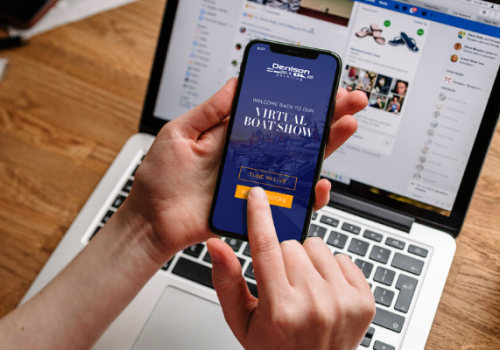
In a global situation where there is high uncertainty, the superyacht sector has not escaped scrutiny of its core operations. The past few months have upended the way yachting companies sell and market their products and services, and businesses have not had the chance to exercise a ‘test-wait-learn’ mindset.
Yachting has traditionally focused on hosting two main types of events: in-person yacht shows and trade fairs; and in-person conferences or forums where a panel of speakers presents to an audience.
In-person events offer yachting brands a number of benefits, including networking, sales opportunities and direct leads. Now, yachting businesses have shifted their priorities and companies are having to rely more on technology to create new events and share multichannel content.
For many industries, digital is normality and they have been embracing in-person and virtual events for a long time. The superyacht sector has had a sharp wake up call, having to transform event strategies overnight. We have always had access to the technology and tools, so why are we so slow to catch up?
In this article, I'd like to:
-
Share commentary about whether some of these options are a step forward for yachting events.
-
Give tips for best practices so that companies can showcase their brand and build emotional rapport digitally.
-
Give free advice for shifting from in-person to virtual/digital events.
-
Share industry insight from yachting professionals about what is working and what’s not.
Shaping the new normal
COVID-19 has highlighted strengths and weaknesses across the yachting industry, especially concerning a brand’s ability to adapt or innovate. Yachting companies have not just had to tweak their business models; they’ve had to rethink everything from event marketing to reframing supply chains.
In the past few months, two common questions I’m asked are “how can we do virtual events?” and “what marketing tools or tips can we use right now?”
Effective communication and marketing opportunities are at the forefront of everyone’s mind. “Without doubt it’s getting the balance right between knowing what to push forward with, where to continue to invest both time and resources and identifying the pockets of opportunity,” says James Ward, CEO at Marine Resources.
“This means re-evaluating everything we do, our offering to our clients, how we structure our packages and how we are going to keep servicing our industry. We should all be talking to each other more than ever, discussing how we can support each other now and in the future, how we can all work better together and make partnerships and relationships stronger.”
So, let’s dive into a closer look at some of the factors related to creating and hosting virtual events and whether the implications are likely to change the communication preferences and needs of the yachting industry from now onwards.
In-person to virtual / digital events
Planning and hosting virtual events requires different marketing, knowledge and tools. We are seeing new roles open up – moderators for webinars, digital-savvy content creators and virtual tech support.
For many yachting companies, they’ve had no prior experience with hosting a large-scale webinar. For many employees, they’ve had to get a grip on new communication tools, particularly videoconferencing platforms - some that they’ve never used prior to 2020.
Which yachting events can go virtual/digital?
-
Sailing regattas
-
Conferences & forums
-
Boat shows
-
Recruitment days
-
Open days
-
Training days / modules
General tips & best practices to help you plan digital events in 2020 & beyond
Approach: Why are people attending your event? What are the actions or outcomes you want participants to align with?
Setup: Decide on the best online channel or platform that suits your message. Every option has its pros and cons. Don’t forget legal considerations such as music, photo or video permissions you may need for your content.
Audience: Put your audience first; your online event is not about you. Consider the length of your event; keep your content concise (especially while people are working from home). Think about the restrictions your audience may encounter such as tuning in from home with distractions around them, using a variety of devices with different capabilities or they may be prone to erratic connectivity. Get creative! How are we as an industry rethinking digital models, making these events interactive and keeping the yachting community engaged?
“As every company is racing to figure out digital, it is important to keep in mind that this is a communication game. The technology is there to assist us but at the end of the day, what you say is more important than what tool you used to say it,” says Art Hill, Owner and Digital Marketing Consultant at Rogue - Marine Business Advisors. “Any marketer will tell you to always reverse engineer what the customers wants. Meaning, there is a big difference between a one-way virtual sales pitch, and an interactive forum where customers can ask questions live, direct someone walking through a boat in real-time, or join online discussions.”
Share an event demo with your own employees first so they know exactly what content is being launched by your company. Share your event agenda with participants in advance via social media and email, including any relevant hashtags.
Branding & Communication: Don’t forget to remain consistent with your company brand identity when you transfer content to digital events – include your logo, brand colours and social media handles.
Mobile Optimisation: Regardless of platform, plan your event with a small screen in mind because smartphones are the main device globally to consume online content. Really think carefully about what details will be viewable and transfer effectively to that format.
Follow-Up: Provide post-event information such as a slide deck with key highlights, a video link or session presentations. Not everyone will be able to attend your event due to scheduling conflicts, so give interested parties the chance to see your content online at a later date.
Various event formats
Pre-Recorded: Content that can be pre-recorded in advance and shared at a later time,
for example, video on demand.
Live Stream/Real Time: Events are streamed live as they happen, with no chance for editing. What you see is what you get!
Rebroadcasts/Playback: Events are pre-recorded, have some editing and are broadcast at a later time.
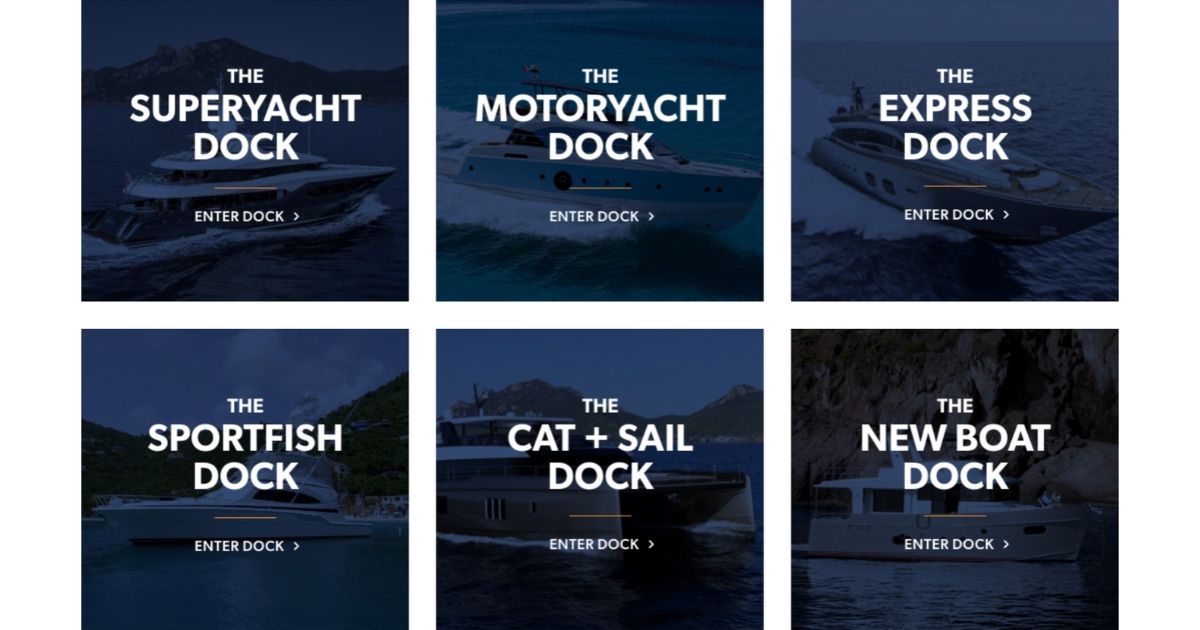 Denison Yachting Virtual Boatshow
Denison Yachting Virtual Boatshow
Planning & hosting virtual boat shows
The superyacht sector has rolled out online boat shows to fill the market gap from face-to-face interactions. Here’s some considerations to help you plan a successful virtual offering and avoid looking at online visitors as passive receivers of content.
1) Environment
While we can’t influence the environment from the participants end, it’s important as an organiser to understand that people may visit your virtual boat show, then leave, then return again and so on. A virtual boat show does not have a linear pathway from show entrance to exhibition zones, so you need to consider how to keep visitors engaged via multi-touch content experiences.
2) User Experience
Rebranding as a virtual boat show means companies need to bring something to the market other than simply publishing a batch of 360° yacht tours, yacht profiles or articles about marine products. We need to rethink the buyer’s journey to keep people engaged, especially when they can find that content online already.
“The key to a good digital event is making it social. Seed the social element and you’ll have strong interaction,” states Ben Taylor, Founder of Flagship Digital Marketing. “From a commercial mindset, digitising boat shows presents an opportunity to reduce costs significantly, appeal to wider audiences and increase the impact of brand awareness. Let hundreds of visitors on a single boat model at once, have the full fleet on the docks, tour a superyacht with complete freedom, test drive a superyacht, why not? The most exciting aspect of a digital experience is the ability to scale it. It helps to keep things simple, but be aware a digital boat show could exceed the attendance of even the largest boat shows the world has seen.”
Think how your digital boat show is going to encourage people to interact with the live chats or book virtual viewings.
Consider creating segment-specific zones for your visitors such as charter, brokerage, design, new build, toys. One missed opportunity I saw is the visible lack of virtual press centres at any of the online boat shows. Media representatives are key facilitators for yachting events regarding exhibitor promotion, announcements and hype. Why not implement a virtual showcase of people who usually support your in-person events? You could have a press zone with digital yachting magazines to browse, journalist and yacht photographer profiles and a ‘News’ feed?
Virtual boat shows won’t entirely replace in-person shows in the future, however put time and research into a platform on which companies, industry professionals and customers can seamlessly interact.
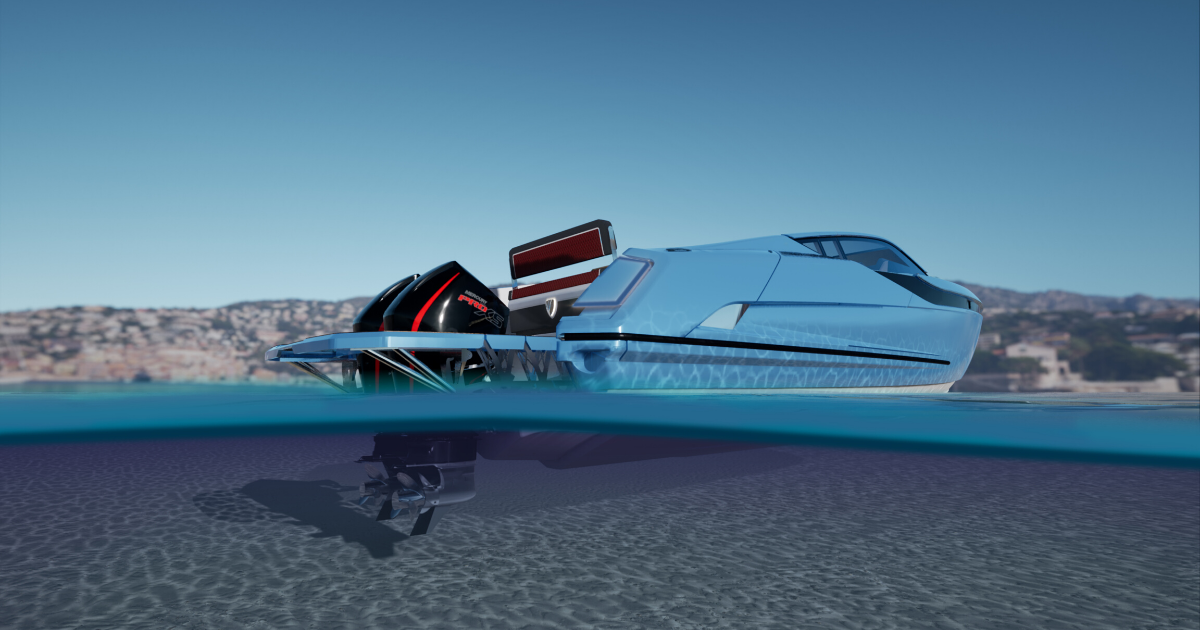
Solidwave Virtual 3D Boat Show app
User experience can be greatly enhanced by the act of browsing exhibition stands. One example I participated in hosted by a software company had global visitors interact in virtual rooms with company experts sharing product demos and answering live questions. It’s a brilliant way to let visitors engage with a brand because it’s more interactive than scrolling through a photo gallery or watching a video.
3) Partner Opportunities
Remember, just because you’ve moved from an in-person event to a digital option, it doesn't mean you should neglect sponsorship partnerships or entertainment.
As mentioned above, sponsors can set up virtual exhibition stands or rooms that people can visit. Once a stand is visited, the guest has the opportunity to interact with a company representative via videoconferencing and live chat. It’s a good concept to scale when exhibitor participation varies greatly.
Entertainment-wise, one events agency has specifically launched entertainment for videoconferencing with various options such as online team-building activities, escape rooms and virtual magicians.
Thinking outside a new narrative
The accepted manner of networking in the superyacht industry has always been face-to-face where we occupy the same real space at the same time – via far too many yearly conferences, forums, workshops and boat shows.
COVID-19 has interrupted this flow and shown us that just because you can launch a virtual boat show doesn’t always mean you should.
While the leaders of the yachting sector are digesting the economic rollercoaster we’re on, has the industry truly embraced innovation and rewritten how to connect with clients and the industry as a whole?
Virtual boat shows should be credited for proving how the industry is working to enhance the in-person experience by offering something slightly different.
From my view, simply transferring previously available content such as walkthrough videos, yacht profiles and photo galleries and rebranding it as virtual isn’t ‘innovative’. It tells people that we still have work to do to understand how to maximise client acquisition, industry engagement and loyalty. No amount of fancy show layouts, advertising or storytelling will find you customers if you can not explain why they should buy from you.
At their core, yacht shows are shared experiences and they remind us that we’re there to build human relationships. Outside of this, we should be clear how virtual boat shows can be repurposed or activated into something new, yet meaningful.
One of the biggest missed opportunities in the creation of virtual boat shows has been ignoring random in-betweens; those wonderful serendipitous moments we have at shows – walking along the quays bumping into industry contacts or surprise invitations as we head from one yacht visit to another meeting and back.
It’s those micro encounters that can lead to finding your next business partner or other great opportunities, and I know that many in the superyacht sector have built strong partnerships from these moments.
Author Reif Larsen has a great quote, “A map does not just chart, it unlocks and formulates meaning; it forms bridges between here and there, between disparate ideas that we did not know were previously connected.”
Being innovative in our industry involves leaving your comfort zone and requires feedback and other points of view. Virtual boat shows have missed replicating this opportunity – to understand that people come before products and embrace these spontaneous moments for thought-exchange with peers.

Planning & hosting webinars
Webinars are traditionally viewed as suitable for lead nurturing and training. If the goal of your event is to make announcements, a webinar may not be a savvy method for this. Here are considerations when planning and hosting webinars:
1) Environment
Often, the elements that separate a good webinar from a great one are due to preparations. Think carefully about creating an appealing environment such as webinar length, Q&A sessions, and aesthetics such as camera placement, good audio and lighting.
Every yachting webinar has been run based on the assumption that all participants have the latest equipment, devices and strong WiFi – be sure to have your webinar transcribed and sent to participants afterwards. This is also advisable as some attendees may have hearing difficulties and want to search the transcribed text to revisit key sections in your webinar.
2) Content
These are interesting times for marketing professionals in yachting and it’s validating why intelligent communication is vital. Make sure your promotion of your webinar includes details such as the duration, agenda and speaker profiles.
One aspect where I think yachting webinars could improve is understanding ‘why’ audiences are joining their webinars. Hosts need to get beyond the ‘death by slides’ or ‘we’re the first ones to bring you this amazing webinar’ mindset. Plan all webinars with your audience in mind:
-
What industry topics or discussions do they care about?
-
Is there demand for this type of content?
-
Are they talking about it online already?
-
What actions do you want them to take after the webinar?
-
How can you grow your brand by hosting this webinar? If you can positively transform someone’s life or yachting business, then they have more reason to participate in your webinar.
Good webinars need good storytelling. It’s better to make one memorable point in your webinar, than cover 10 forgettable topics.
3) Emotional Connection
Yachting companies have created their idea first, then tried to find webinar platforms to host their concept. Throughout your planning remember that the most successful webinars are conversations, not presentations. Participants do not need to waste their time joining to watch a one-sided infomercial!
It may seem obvious, but not everyone has engaging charisma or confidence on camera. The best speakers are those who have the skills and authenticity to present the key messages of your webinar. Being available is not a skill, so have great speakers host your webinars.
It’s not just about creating relevant content for your webinar, but making sure you can transfer the excitement for that webinar to the industry. It’s possible to drive registrations, build brand awareness AND form an emotional reaction.
Be mindful of participant management, because facilitating conversations via webinars can be difficult compared to in-person events such as yachting forums. Don’t underestimate the energy and interactions that attendees can trigger during a webinar, especially if you’re discussing current topics you should keep an eye on chat feeds as they can quickly go astray.
Don’t omit telling the audience when and how they can ask questions e.g. a 15-minute Q&A session will be held at the end of the webinar.
Include social media in your webinar strategy – get participants to live tweet, use the event hashtag or share presentations before, during and afterwards.
4) Transformative
When participants invest their time in your webinar you must consider why they should feel like their time was well-spent. Think about how your webinar can support the industry on a whole. Does your content have the potential to change someone’s mindset or behaviour?
5) Follow-Up
Data and intelligence is hugely useful to marketers so we can create better events, and we now have incredible data points we didn’t have 3 months ago. To date, I’m not convinced that yachting companies are using data on their audience’s behaviours and needs to create truly memorable experiences. Some webinars haven’t responded to participant questions, nor have they asked participants for post-webinar feedback.
As an industry, if we forget to ask people for their feedback about our processes then we have less opportunity to target and engage clients. We’re missing the cultural nuances by ignoring the valuable silos of data from these interactions.
Many companies have had to cancel in-person yachting events, yet they can try to offset the financial losses by using their webinar content as an online resource. It gives their effort an outlet to attract new business.
Don’t forget to advise attendees where you will distribute the recording afterwards. You can send them a link to the webinar recording, transcript (including Q&s) and a copy of the slide deck. If you use a slide deck, keep in mind that it should stand alone as a presentation. Having enough context by itself means if your audience finds it online in 3 months, 6 months or 1 year it makes sense. Organise your webinar recordings by category to make it user-friendly for viewers, for example, new build, charter etc.
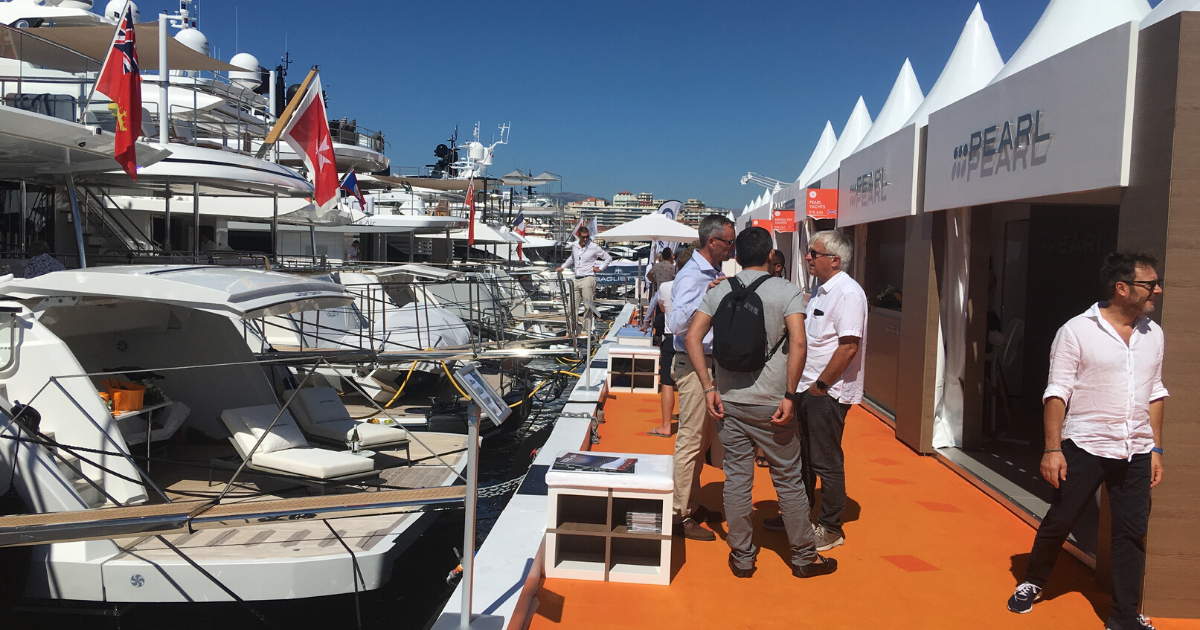
Will yacht shows be a thing of the past?
Webinar / videoconferencing options
Video conferencing apps have seen record downloads in the first quarter of 2020. Their use has been an equaliser for competing superyacht brands, because it has forced brands to reimagine their content as well as industry relationships.
Some platforms have been inflicted with security and privacy concerns such as Zoom-bombing incidents. Businesses have also had to manage online interactions as viewers come and go.
Typical considerations when choosing a platform are:
-
What is your budget? Can you afford subscription services?
-
How many speakers can you have at one time?
-
How many participants do you expect for your event?
-
Do attendees have to download/install plugins, apps or additional software? What OS and devices can they use?
-
Is the registration process easy for participants?
-
What features do you need at the time of the webinar (white boarding, screen sharing, transcribed captions etc.)?
-
Do you need integrated tools for promotion, sign-ups and analytics?
Some videoconferencing options are:
-
ON24
-
Airmeet
-
BlueJeans
-
ClickMeeting
-
EasyWebinar
-
EverWebinar
-
ezTalks
-
Google Meet
-
GoToWebinar
-
GlobalMeet
-
HopIn
-
Me
-
LiveStream
-
Skype
-
Slack
-
WebEx
-
WebinarJam
-
Zoom
In our next article in this series, we highlight a few virtual platforms and technology to watch for the future!
How to make your webinars interesting
Yachting webinars have had seated presenters and haven’t opted to include dynamic speaker presentation or backdrops. Here’s ten ideas to make your webinar interactive and/or interesting:
-
Live chat
-
Using real-time closed captions / live captions; Ensure that content is accessible for visual and hearing impaired audiences. If you plan for a global audience, consider translation services for captioning.
-
Live participation – create an official event hashtag that your attendees can tweet during your event. It means they can participate, your content will reach more people and you can track what sections of your webinar are most popular.
-
Gamification
-
Exclusive product offers during live sessions
-
Use of graphics, animation, typography, fun backdrops, photos and videos
-
Have a surprise guest speaker
-
Q&A’s
-
Real-time quizs
-
Polls and surveys
Ben Taylor continues: “Digital elements in yachting such as social media, AI or machine learning has forever been undervalued. The importance today is amplified by the situation we’re facing. It’s allowing brands to continue providing consistent and engaging experiences to its audience. Brands will outlive the difficult times.”.
Looking to the future
Yachting webinars have been great for brand awareness and thought leadership, and most organisers have been mindful that there’s a learning curve. However, we’re not as innovative as we could be and perhaps need to respect other industries who have been forward-thinking in this space for years and dominate best practices.
I believe we’ve only just touched the surface regarding people, planning and platforms that will improve yachting events in the future. As individuals and companies become more comfortable with communication channels and the actions that digital technologies unlock, they will keep adapting and being receptive to new concepts and ways of working.
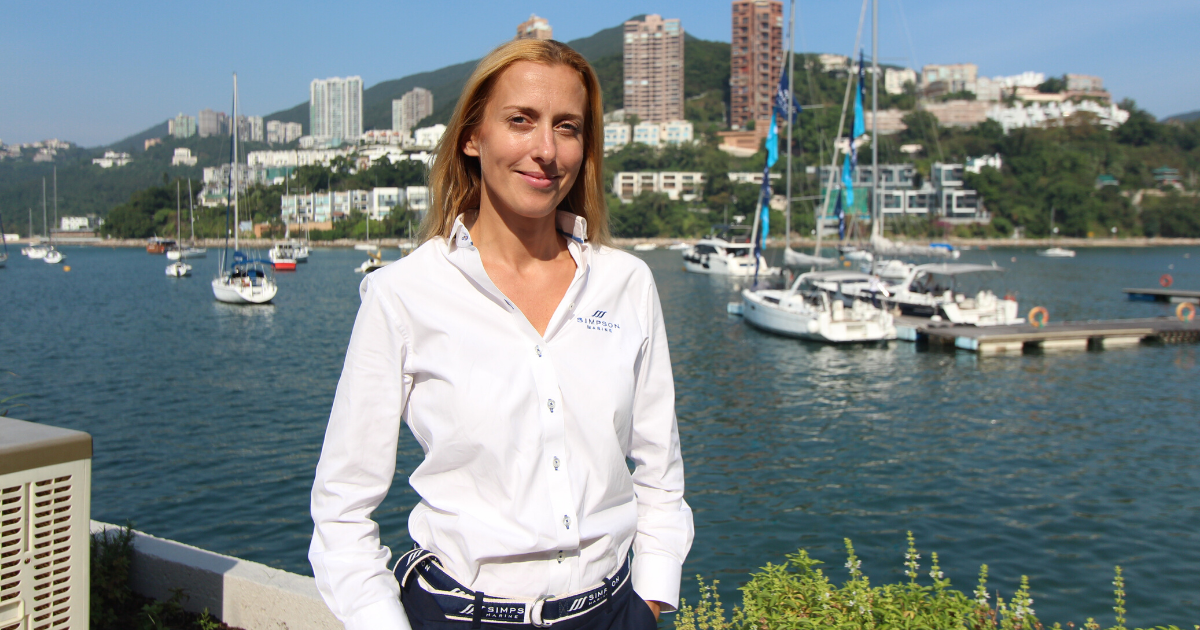
Ewa Stachurska, Group Marketing Manager, Simpson Marine
“It has had a huge impact on our work planning as we organise/participate in roughly 45 events annually and many of them happen in the first half of the year, including major Asian yacht shows such as Singapore Yacht Show, the bi-annual Taiwan Boat Show, as well as the most important Art Fair in Asia, Art Basel Hong Kong in which we are involved through Sanlorenzo and their global partnership with Art Basel,” confirms Ewa Stachurska, Group Marketing Manager at Simpson Marine.
“We cover seven countries with 12 offices across Asia, therefore we are familiar with remote communication. Due to the postponement or cancellation of in-person events, our budgets have had a big shift to digital. We foresee that locally focused events that don’t require guests to travel will be most popular in the coming year, and this supports our aim to reactivate markets in Mainland China, Hong Kong and Taiwan first, followed by Singapore, Malaysia and Thailand.”
Regardless, whether it’s in-person, online, offline or a hybrid event we must think long-term how to connect the yachting community. Ultimately, effective communication can mix the physical, emotional and the digital in ways that we never imagined before.
Our next OnboardOnline article is the final one in this three-part series and will focus on e-learning, e-commerce and new technology for virtual events.
Images: Denison Yachting, supplied, Solidwave

Post your comment
You cannot post comments until you have logged in.
Login to post a commentComments
No one has commented on this page yet.
RSS feed for comments on this page | RSS feed for all comments